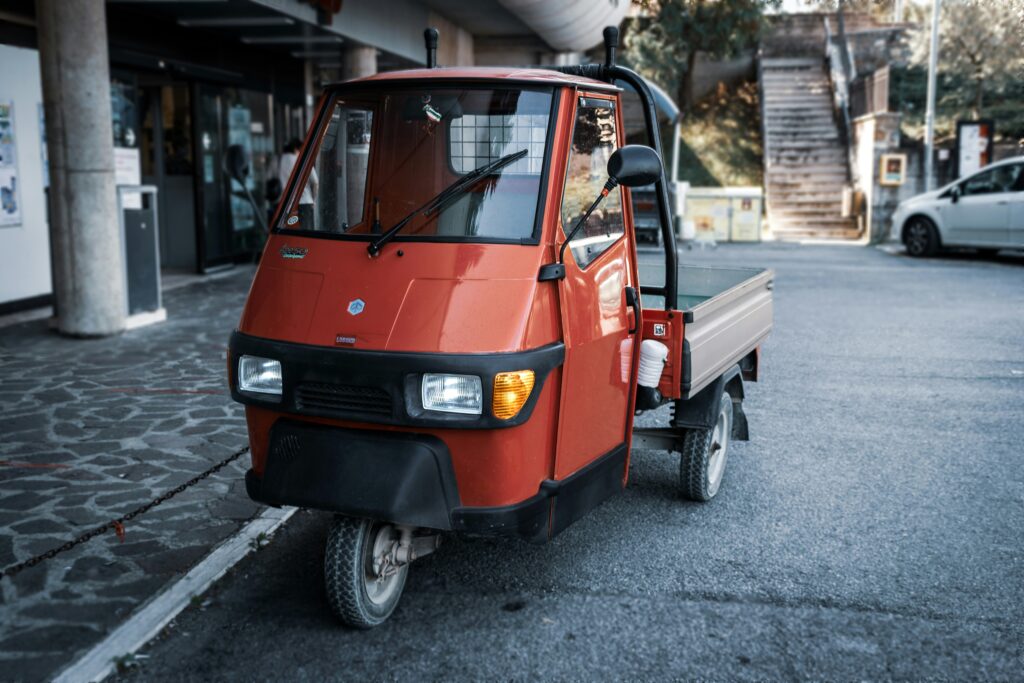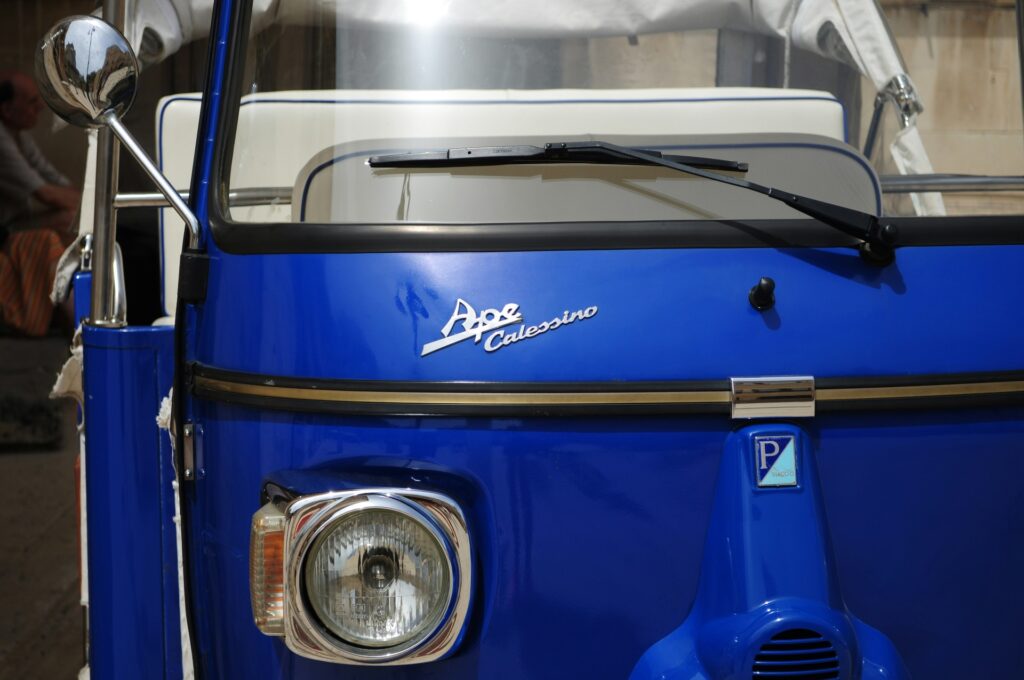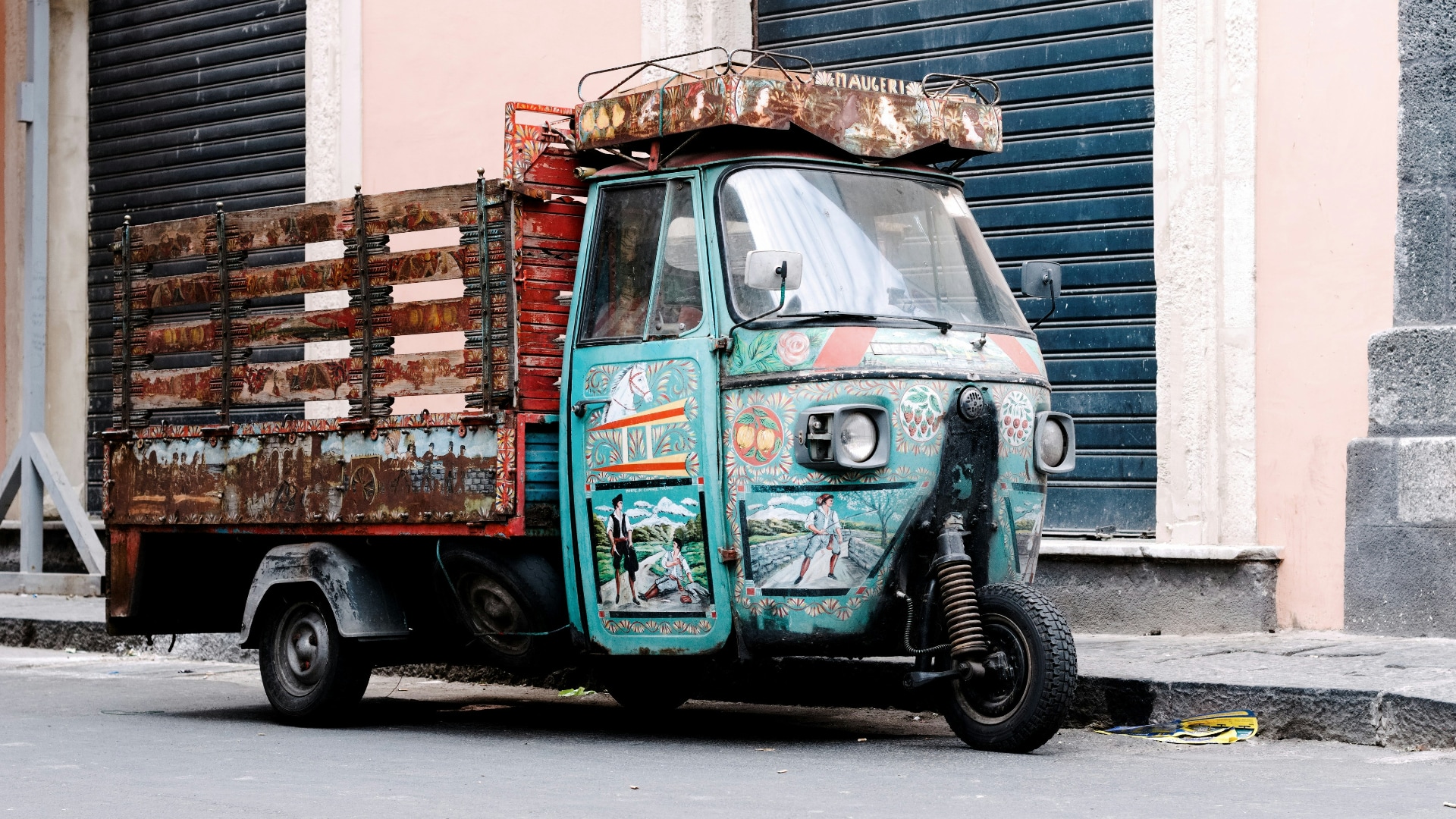It is not only suitable as an inexpensive means of transportation, but is also often used as a mobile advertising medium. It is perfect for this because it is a real eye-catcher. A company logo or advertising slogan attached to the box body immediately catches the eye. An image of a crispy ice cream cone filled with delicious Italian gelato, for example, is really something. Or a photo of crunchy, sun-ripened tomatoes that look particularly fresh when they are sprinkled with drops of water.
The multifunctional Vespacar that is always ready for action
The small, likeable Ape is not only ideal for transportation of all kinds. It also impresses with its functionality, economy and, last but not least, its characteristic design. Like the Vespa, the three-wheeled van has become a popular, trendy and indispensable vehicle for many small businesses and self-employed people. Unfortunately, the Ape will gradually disappear from the European cityscape. It will only be produced in India. We already know that the Piaggio Ape has achieved cult status. But who used this unique vehicle?
- Janitor services, contractors, suppliers
- Wine growers harvesting their grapes
- Street vendors of all kinds (ice cream, snacks, sweets, haberdashery, etc.)
- Gastronomy for the purchase of goods, as a mobile kitchen or sales stand for street food
- Fruit and vegetable traders, for example at the weekly market
- Transportation in urban areas or narrow alleyways where larger vehicles often have difficulties
- For leisure, hobbies or even the beach

Various models were manufactured in series production
The most popular model was the Ape 50 with platform body. The original Ape model was characterized by mobility, compactness, economy and fuel consumption. It was ideal for driving on narrow, curvy roads and narrow streets in the city. But the Ape also scored well in the countryside. The Ape 50 Cross could be ridden by young people aged 15 and over with an AM driving license. The Ape was not only a means of transportation, but also – if you like – the first mini pick-up that could be purchased on the market. Equipped with roll bars, metal bumpers at the front and rear and its overall appearance in general, it attracted a lot of attention.
The following models were produced at the Pontedera plant:
- Ape 50
- Ape 125
- Ape 200
- Piaggio Ape Classic 400
- available with different bodies: box body and platform body
- available to order: variant without bodywork
The Ape as a means of transportation without a body was mainly in demand among tinkerers and DIY enthusiasts. These special groups of people gave free rein to their imagination in terms of possible uses and advertising design.
Unrecognizable from the outside, it was possible to upgrade it with a car radio. This fact and the unique selling point made the Ape attractive and interesting for young people. When the driving license regulations were amended in December 2016, the official 25 km/h version of the Ape was already available from the factory. From then on, the official regulations applied as for the moped.
If you want to explore the world of the Ape in more depth, you will find lots of exciting information and beautiful illustrations in the Handbook APE PIAGGIO 70 anni / 70 years manual by Giorgio Sarti.

Between transporter and mobility aid
Many years earlier, it had already been possible to convert 25 km/h versions of the Ape 50 in Germany. However, these retrofitted Ape models could only be used on the road as a wheelchair for handicapped people. Yes, you’ve read that right: as an invalid chair for disabled in road traffic. This means nothing other than that some Vespacars used to rattle around as motorized wheelchairs. The loading areas were locked and only people with disabilities were allowed to drive them on the roads. Hard to imagine in today’s world.
Where there is light, there are also shadows. Unfortunately, there were numerous misunderstandings because the maximum permitted speed of 25 km/h was often mistaken for a driving license for mopeds. However, this was not the case. This gray area only disappeared with the new regulation in 2016.
Technical data of the Ape
- Engine single-cylinder/two-stroke with 50 cm³ displacement
- Electric starter, electronic ignition
- Battery 12 V, 32 Ah
- Air-cooled
- Mono chassis with self-supporting bodywork
- Steering rod control
- Gearshift 4 gears and 1 reverse gear
- Tank capacity 10 liters, max. speed 37 km/h
- Turning circle 6 m
- Payload box: 145 kg, flatbed 170 kg
Conclusion
The first Ape met the requirements of the post-war market. Goods transportation and mobility were in demand, but resources and money were scarce. As the name Ape (Italian for “bee”) suggests, the name refers to the agile and maneuverable nature of the small truck. The Ape was thus born as the desired practical and cost-effective alternative to the much more expensive commercial vehicles of the time.
Whether as an open platform truck or a closed box body, the Ape quickly became popular and indispensable. It’s just a shame that it fell victim to the short-lived times and their strict regulations, at least in Europe.



